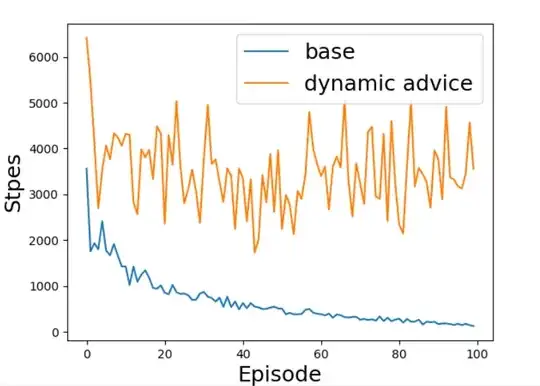I am trying to reproduce the results for the simple grid-world environment in [1]. But it turns out that using a dynamically learned PBA makes the performance worse and I cannot obtain the results shown in Figure 1 (a) in [1] (with the same hyperparameters). Here is the result I got:

The issue I found is that the learning procedure is stuck due to bad PBA in the early stages of training. Without PBA, Sarsa can converge well.
Did anyone try the method before? I am really puzzled and how the authors obtain these good results? There are some top conference papers using the same method in [1], for example, [2] and [3].
[1] Expressing Arbitrary Reward Functions as Potential-Based Advice
[2] Learning from demonstration for shaping through inverse reinforcement learning
[3] Policy Transfer using Reward Shaping
Is the method itself defective or anything wrong with my code? Here is part of my codes:
import copy
import numpy as np
import pandas as pd
def expert_reward(s, action):
if (action == RIGHT) or (action == DOWN):
return 1.0
return 0.0
class DynamicPBA:
def __init__(self, actions, learning_rate=0.1, reward_decay=0.99):
self.lr = learning_rate
self.gamma = reward_decay
self.actions = actions
self.q_table = pd.DataFrame(columns=self.actions, dtype=np.float64) #q table for current time step
self.q_table_ = pd.DataFrame(columns=self.actions, dtype=np.float64) #q table for the current time step
self.check_state_exist(str((0,0)))
def learn(self, s, a, r, s_, a_): #(s,a) denotes current state and action, r denotes reward, (s_, a_) denotes the next state and action
self.check_state_exist(s_)
q_predict = self.q_table.loc[s, a]
q_target = r + self.gamma * self.q_table.loc[s_, a_]
self.q_table.loc[s, a] = self.q_table.loc[s, a] + self.lr * (q_target - q_predict)
def update(self):
self.q_table = copy.deepcopy(self.q_table_)
def check_state_exist(self, state):
if state not in self.q_table.index:
# append new state to q table
self.q_table = self.q_table.append(
pd.Series(
[0]*len(self.actions),
index=self.q_table.columns,
name=state,
)
)
self.q_table_ = self.q_table_.append(
pd.Series(
[0]*len(self.actions),
index=self.q_table_.columns,
name=state,
)
)
#######Main part
RL = SarsaTable(actions=list(range(len(actions_dict))), reward_decay=0.99, learning_rate=0.05)
expert = DynamicPBA(actions=list(range(len(actions_dict))), learning_rate=0.1, reward_decay=0.99)
for episode in range(100):
# initial observation
s = (0,0)
env.reset(s)
action = RL.choose_action(str(s))
r_episode_s = 0
r_episode = 0
current_step = 0
while True:
# RL take action and get next observation and reward
s_, _, reward, status = env.step(action)
current_step += 1
action_ = RL.choose_action(str(s_))
# update dynamic potentials
expert_r = -expert_reward(s, action)
expert.learn(str(s), action, expert_r, str(s_), action_)
# compute PBA
F = expert.gamma * expert.q_table_.loc[str(s_), action_] - expert.q_table.loc[str(s), action]
#update expert PBA table
expert.update()
RL.learn(str(s), action, reward+F, str(s_), action_, status)
# swap observation
s = s_
action = action_
# break while loop when end of this episode
if status != 'not_over':
break
if current_step>10000:
print(episode, r_episode, r_episode_s, current_step)
break
# learning rate decay
RL.lr = RL.lr*0.999
# expert.update()